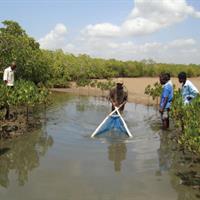Dynamics of Milkfish Farming in Kenya
 Using a push net to capture wild milkfish fry from a mangrove channel.
Using a push net to capture wild milkfish fry from a mangrove channel.Mariculture development in Kenya started about three decades ago when initial attempts were made, including a survey to identify suitable areas for shrimp farming, with a focus on suitability of soils and tidal range (Yap and Landoy 1986). This led to the development of commercial mariculture in the 1980s, funded by the FAO, to culture prawns at Ngomeni, in northern Kenya, with a total estimated area of 60 ha (UNEP 1998, Rönnbäck et al. 2002). Target species were Indian white prawn Penaeus indicus and tiger prawn Penaeus monodon. However, other species (e.g. rabbitfish, mullet and milkfish) that co-occurred in culture ponds informed the choice of species for the current interventions (Sivalingam 1981, Mirera 2007a). Prawn culture flourished but was not able to sustain itself at the end of the FAO project period.
Since the initial FAO interventions, mariculture has evolved into farming of several marine species by organized community groups with limited production for local market (Shimpton and Hecht 2007). One of the candidate culture species along the coast of Kenya is milkfish Chanos chanos, which has been farmed since 2005 in intertidal earthen ponds that are characterised by high salinities and pronounced temperature fluctuations (Mwaluma 2003, Mirera and Ngugi 2009, Mirera 2011a).
History of Milkfish Farming in Kenya
In the 1980s, milkfish was considered a byproduct of prawn farming (Mirera 2007a). However, in the recent past it has been promoted as a key culture species along the coast of Kenya with some level of success because of its faster growth, tolerance to high fluctuations in salinity and temperature and availability of wild seed (Mirera 2011a). Initial observations of the ability of milkfish to withstand high salinity and temperatures fluctuations were made in 2000 (Mwaluma 2003).
Community and village-based milkfish farming was initiated about two decades ago with a focus in three of the five coastal counties (Kwale, Mombasa and Kilifi). To date milkfish farming has only expanded in the original counties while the other two coastal counties (Tana River and Lamu) have remained without milkfish farming despite the existing potential. Farming is spearheaded by organized community groups. These groups also participate in other activities such as advocacy and conservation of mangrove forests (Fig. 1). Thus, milkfish farming provides a financial and livelihood motivation for the communities to engage in mangrove management and conservation (Mirera 2011a).
The number of organized community groups involved in milkfish farming along the Kenyan coast has increased from 5 in 2007 to 56 in 2015, while the area of milkfish farms has also increased significantly over the same period (Mirera, 2007a). The size of fishponds used by these groups in milkfish culture has increased from the initial 12 m × 10 m (120 m2) to the current 40 m × 30 m (1200 m2) through the intervention of a World Bank funded project called the Kenya Coastal Development Project (KCDP) (Mirera 2016; Fig. 2).
Milkfish Production Systems
The farming of milkfish in Kenya was initiated in small (120 m2) earthen ponds in open intertidal flats in mangrove forests. The sites were carefully selected on the basis of the suitability of soils for pond construction, limited possibility for mangrove cutting and where gradients were good for tidal water exchange. Ponds were fitted with drain pipes on the upper side of the dyke to allow free exchange of tidal water at high spring tides while the lower section was designed and fitted with a relatively large diameter pipe for drainage during harvesting (Mirera 2011a). This minimized the time required for water exchange because it could occur without the presence of farmers. In addition, the cost of pipes was far less than that required to construct sluice gates. After construction, ponds were prepared with applications of lime and fertilizer before stocking seed collected from the wild about one week after fertilization.
Although current pond designs remain similar to initial ponds, the size was increased to commercial scale (1200 m2) through the support of the KCDP over the last three years (Mirera 2016). The larger size has also taken into consideration the original concerns about mangrove conservation that were envisioned in the development of milkfish farming in Kenya.
Milkfish Seed Sources
There is no marine hatchery on the coast of Kenya, likely related to the high investment costs required to operate the facility and the unwillingness of the government to prioritize mariculture development. Therefore, most of the research and production of milkfish on the coast depends solely on seed sources from wild stocks. Seed are collected by fishers in natural intertidal pools and shallow mangrove channels during incoming tides or at low tides (Fig. 3). Push nets and small seines are employed to collect seed, which are in most cases of variable sizes and at times species (Mirera 2011a). Collected milkfish seed are quickly sorted to release non-target species before packaging and transport to farms for further sorting and stocking in ponds.
Fingerling surveys conducted along the coast of Kenya have indicated seasonal appearance of milkfish. The most abundant season is in March — July while the less abundant season is September — December (Mirera 2011a). This indicates that farmers must undertake proper planning to benefit from the seasonal occurrence of milkfish seed or production may not be achieved in the farm for a whole year.
Read the rest of this article in the March 2017 issue of World Aquaculture Magazine here